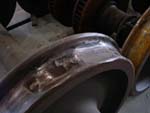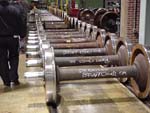Seasonal issues that may impact
Connecticut Commuter Rail Service![]()
Flat Wheels
 |
 |
| Flat spots on train wheels | Repaired flat spots |
The main reason for flat spots to occur is the falling of leaves onto the rail tracks. As the leaves fall, a residue is left by the seasonal foliage, creating a reduced traction condition where the train wheels slip along the track during braking. When the engineer applies the brake, the train wheel may stop turning creating friction that wears down the wheel and making the flat spot. To repair these flat train wheels, the rail car must be taken to the Wheel Truing Shop in New Haven where the wheels are ground to a new round smooth finish. The Wheel Truing Shop operates 24-hours a day, 3-shifts, 7 days a week. Repairs can take up to 8 hours to grind 4-wheel sets, which is equivalent to one rail car.
What can be done to prevent flat spots?
In order to reduce the frequency of flat spots, each rail car is equipped with a decelostat or “slip-slide” system. This functions much like the anti-lock braking systems found on automobiles and pluses the brakes so that one single point does not take all the wear. CDOT also is currently building a new state of the art Wheel Truing Repair facility in New Haven to further expedite repairs to the rail fleet. This new maintenance facility is under the design and construction phase.
How will I know if a passenger car has flat spots?
As a passenger you may experience a train with a flat spot. It is similar to the sound when your motor vehicle has a flat tire. A rhythmic thumping noise is heard as the vehicle is moving, the slower the motion, the louder the thumping. In most cases, flat spots have no impact on the train operations. Trains can and will be run with small flat spots on the wheels. Only flat spots greater than 1.5 inches require truing.
During this time of the year, several rail cars may be out of service at any given time to perform maintenance which in turn may impact your daily commute. We ask for your patience and understanding as we enter into the Fall!
Winter Conditions
As winter season approaches, other seasonal conditions may impact the rail cars such as snow, ice, and the colder temperatures. Back in the winter of 2004, the New Haven Rail Fleet experienced dramatic consequences from the severe winter weather. The snow, especially light fluffy snow, can enter in to the electrical system from the under belly of the train. As the snow melts, it may short out the electrical equipment impacting the service and removing several passenger cars from use. In the winter of 2003-04, 120 passenger cars out of the 343 M-Fleet were unavailable for service during that winter. One the worst day in the winters of 2004-05, 106 passenger cars were out of service, impacting seating capacity.
Fluffy Snow
Metro-North Railroad, the ConnDOT operator of the New Haven Line, has put into place a variety of preventative maintenance items to reduce severe winter weather impacts, specifically fluffy snow impacting electrical rail equipment.
Specific additional actions taken by Metro North to reduce winter weather impacts are:
- Increase inspections on air filtration to prevent snow ingestion
- Perform inspections of control system heating units to insure working properly
- Additional air driers, and perform inspection of pantographs
- Additional part inspections and replacements conducted on:
- gaskets and under car electrical boxes
- door thresholds are heated to prevent doorways from freezing
- slush guards on rail shoe mechanisms
- snow shoes to prevent snow build up
- coupler covers to prevent snow from getting into electrical couplers
- horn covers
Furthermore, ConnDOT has investigated with our northern colleagues in Canada, how they best address the issue from severe colder weather and snow fall to learn best practices and applied lessons learned. One major issue for failure is having electrical equipment placed under the rail cars. The new cars, M-8’s, will have as much of the equipment placed inside as possible in order to reduce impact from outside elements. Another step that our northern passenger rail authorities do is to simply reduce the amount of equipment use in the worst weather conditions. This is something their passengers expect each year, and part of the ConnDOT effort to increase public awareness on our commuter rail service.

